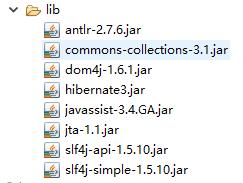hibernate添加数据入门小案例
Posted java小斌
tags:
篇首语:本文由小常识网(cha138.com)小编为大家整理,主要介绍了hibernate添加数据入门小案例相关的知识,希望对你有一定的参考价值。
1.建立一个java项目,在目录下新建一个lib文件夹引入hibernate架包如图所示:

2. 新建com.LHB.domain包,在包中分别创建一个Employee.java和Employee.hbm.xml文件,
Employee.java中的代码如下:
1 package com.LHB.domain; 2 3 import java.util.Date; 4 //该pojo/javabean/domain按照规范应当序列化,目的是可以唯一的表示该对象呢,同时可以在网络和文件传输 5 public class Employee implements java.io.Serializable { 6 private static final long serialVersionUID = 1L; 7 private Integer id; 8 private String name; 9 private String email; 10 private Date hiredate; 11 public Integer getId() { 12 return id; 13 } 14 public void setId(Integer id) { 15 this.id = id; 16 } 17 public String getName() { 18 return name; 19 } 20 public void setName(String name) { 21 this.name = name; 22 } 23 public String getEmail() { 24 return email; 25 } 26 public void setEmail(String email) { 27 this.email = email; 28 } 29 public Date getHiredate() { 30 return hiredate; 31 } 32 public void setHiredate(Date hiredate) { 33 this.hiredate = hiredate; 34 } 35 36 }
Employee.hbm.xml映射文件配置如下:
1 <?xml version="1.0" encoding="utf-8"?> 2 <!-- 映射文件通过DTD来指定格式 --> 3 <!DOCTYPE hibernate-mapping PUBLIC 4 "-//Hibernate/Hibernate Mapping DTD 3.0//EN" 5 "http://hibernate.sourceforge.net/hibernate-mapping-3.0.dtd"> 6 <!-- 该文件用于配置domain对象和表的映射关系 --> 7 <hibernate-mapping package="com.LHB.domain"> 8 <class name="Employee" table="employee" > 9 <!-- id元素用于指定主键属性 --> 10 <!-- 11 <id name="id" column="id" type="java.lang.Integer"> 12 该元素用来指定主键生成的策略hilo native increment sequence uuid 13 <generator class="sequence"> 14 <param name="sequence">emp_seq</param> 15 </generator> 16 </id> 17 --> 18 <!-- 在更改数据库时对主键生成策略做了修改 --> 19 <id name="id" column="id" type="java.lang.Integer"> 20 <generator class="increment"></generator> 21 </id> 22 <!-- 如果id号希望用户自己设定,而不是由数据库mysql --> 23 <!-- <id name="id" column="id" type="java.lang.Integer"> 24 <generator class="assigned"/> 25 </id> --> 26 <!-- 对其它属性还要配置 --> 27 <property name="name" type="java.lang.String"> 28 <column name="name" not-null="false" /> 29 </property> 30 <property name="email" type="java.lang.String"> 31 <column name="email" not-null="false" /> 32 </property> 33 <property name="hiredate" type="java.util.Date"> 34 <column name="hiredate" not-null="false" /> 35 </property> 36 </class> 37 38 39 </hibernate-mapping>
3.在项目src文件下创建hibernate.cfg.xml配置文件,其中的配置信息如下:
1 <?xml version="1.0" encoding="utf-8"?> 2 <!DOCTYPE hibernate-configuration PUBLIC 3 "-//Hibernate/Hibernate Configuration DTD 3.0//EN" 4 "http://hibernate.sourceforge.net/hibernate-configuration-3.0.dtd"> 5 6 <hibernate-configuration> 7 <session-factory> 8 <!-- 配置使用的driver --> 9 <property name="connection.driver_class">com.mysql.jdbc.Driver</property> 10 <property name="connection.username">root</property> 11 <property name="connection.password">123456</property> 12 <property name="connection.url">jdbc:mysql://localhost:3306/test</property> 13 <!-- 配置dialect方言,明确告诉hibernate连接哪种数据库 --> 14 <property name="dialect">org.hibernate.dialect.MySQLDialect</property> 15 <!-- 显示出对应的sql语句 --> 16 <property name="show_sql">true</property> 17 <!-- 让hibernate给我们自动创建表 creat:如果mysql中没有该表则创建,如果有表则删除再创建 18 update:如果没有表则创建新表,如果有表则看表结构有没有变化,如果有变化则创建新表--> 19 <property name="hbm2ddl.auto">update</property> 20 <!-- 指定管理的对象映射文件 --> 21 <mapping resource="com/LHB/domain/Employee.hbm.xml"/> 22 23 </session-factory> 24 </hibernate-configuration>
4. 创建一个测试类TestMain
1 package com.LHB.view; 2 3 import java.util.Date; 4 5 import org.hibernate.SessionFactory; 6 import org.hibernate.Transaction; 7 import org.hibernate.cfg.Configuration; 8 import org.hibernate.classic.Session; 9 10 import com.LHB.domain.Employee; 11 import com.LHB.util.MySessionFactory; 12 13 public class TestMain { 14 15 public static void main(String[] args) { 16 // TODO Auto-generated method stub 17 18 updateEmp(); 19 //addEmployee(); 20 } 21 /** 22 * 删除用户 23 */ 24 private static void delEmp() { 25 //删除 26 //获取一个session 27 Session session = MySessionFactory.getSessionFactory().openSession(); 28 Transaction transaction = session.beginTransaction(); 29 try { 30 //修改1.先获取该雇员,然后删除 31 Employee employee=(Employee) session.load(Employee.class, new Integer(3)); 32 session.delete(employee); 33 transaction.commit(); 34 session.close(); 35 36 }catch (Exception e) { 37 if(transaction!=null) { 38 transaction.rollback(); 39 } 40 41 throw new RuntimeException(e.getMessage()); 42 } finally { 43 //关闭session 44 if(session!=null&&session.isOpen()) { 45 session.close(); 46 } 47 48 } 49 } 50 /** 51 * 更新用户 52 */ 53 private static void updateEmp() { 54 //修改用户 55 //获取一个会话 56 /*Session session = MySessionFactory.getSessionFactory().openSession(); 57 58 Transaction transaction = session.beginTransaction(); 59 //修改用户1.获取要修改的用户,2.修改 60 //load是可以通过主键属性,获取该对象实例,《----》表的记录对应 61 Employee employee = (Employee)session.load(Employee.class, new Integer(3)); 62 employee.setName("张三"); 63 transaction.commit(); 64 session.close(); 65 */ 66 //添加事务回滚优化之后 67 Session session = MySessionFactory.getSessionFactory().openSession(); 68 Transaction transaction = null; 69 try { 70 transaction = session.beginTransaction(); 71 //do... 72 Employee employee = (Employee)session.load(Employee.class, new Integer(1)); 73 //用户指定id号 74 //employee.setId(new Integer(100)); 75 employee.setName("李四"); 76 employee.setEmail("lisi@sohu.com"); 77 78 /*//异常 79 int i=9/0; 80 //.... 81 */ transaction.commit(); 82 83 84 }catch (Exception e) { 85 if(transaction!=null) { 86 transaction.rollback(); 87 } 88 89 throw new RuntimeException(e.getMessage()); 90 } finally { 91 //关闭session 92 if(session!=null&&session.isOpen()) { 93 session.close(); 94 } 95 96 } 97 98 99 } 100 /** 101 * 添加用户 102 */ 103 public static void addEmployee() { 104 //使用hibernate完成crud操作 105 //现在不使用service,直接测试 106 //1.创建Configuration,该对象用于读取hibernate.cfg.xml并完成初始化 107 Configuration configuration = new Configuration().configure(); 108 //2.创建SessionFactory【这是一个会话工厂,是一个重量级的对象】 109 SessionFactory sessionFactory = configuration.buildSessionFactory(); 110 //3.创建Session,相当于jdbc中的Connection 111 Session session = sessionFactory.openSession(); 112 //4.对于hibernate,要求在进行增加,删除,修改的时候使用事物提交 113 Transaction transaction = session.beginTransaction(); 114 115 try { 116 117 //添加一个雇员 118 Employee employee = new Employee(); 119 employee.setName("zhangsan"); 120 employee.setEmail("zhangsan@126.com"); 121 employee.setHiredate(new Date()); 122 123 //保存,把对象保存到数据库 124 session.save(employee);//相当于insert into....[被hibernate封装] 125 transaction.commit(); 126 session.close(); 127 128 }catch (Exception e) { 129 if(transaction!=null) { 130 transaction.rollback(); 131 } 132 133 throw new RuntimeException(e.getMessage()); 134 } finally { 135 //关闭session 136 if(session!=null&&session.isOpen()) { 137 session.close(); 138 } 139 140 } 141 } 142 143 }
以上是关于hibernate添加数据入门小案例的主要内容,如果未能解决你的问题,请参考以下文章